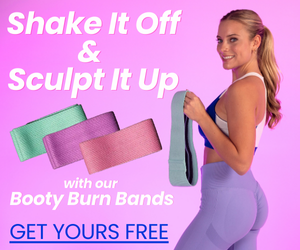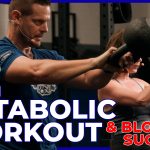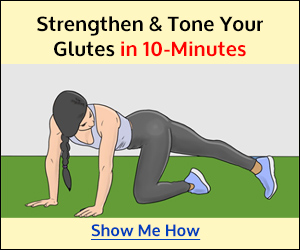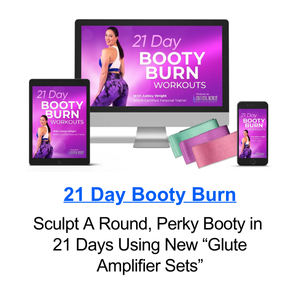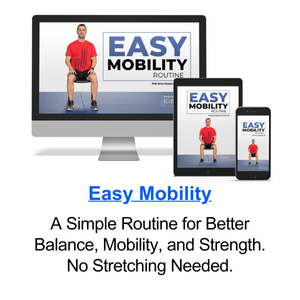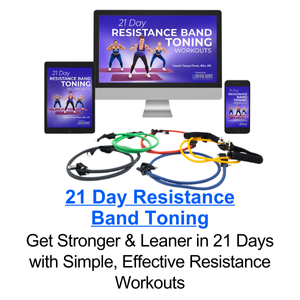THE KEYS TO SUPERHUMAN STRENGTH
The quest for physical power has been with us since time began. Every civilization throughout the ages has had its mythical strongmen. Hercules, Samson, Thor, Atlas… The list goes on and on. In the last century, strongmen and women appes/ared on stage thrilling audiences with lifting, bending, and breaking feats that defied imagination. More recently, men like Paul Anderson, Valisli Alexeev, and Bill Kazmaier have provided the same excitement to modern strengths fans. The early bodybuilding champions were also excellent weightlifters or could use tremendous poundage’s in various “odd lifts.’
In today’s world of specializations, you are expected to choose if you want to be the best. You are a bodybuilder, power lifter, or an Olympic lifter. Never the twain shall meet. The “Power-Body” has become a fourth of strength athlete. He is much admired by the general public. Either with all the TV and media exposure given to bodybuilding, Mr. And Ms. Average have a hard time understanding why anyone would put so much time into building muscles if all they can do with them is flex them. When they see a muscular person, the first thing they ask is “How much can you lift?”
Ever since I’ve gotten in MUSCLAR DEVELOPMENT magazine, I have received so many requests from beginners and veteran body builders alike, for information on building outstanding power. As a reply, I give you this series.
I have important statement to make: “I am NOT a power lifter and I MAKE NO CLAIMS TO ANY WORLD RECORD. I have nothing but respect and admiration for men like Anthony Clark, Ted Arcidi, Ken Lane, and my good friend Chris Confessori. THESE MEN ARE WORLD RECORD HOLDERS AND ARE THE VERY BEST AT WHAT THEY DO.
I am a PROFFESSIONAL STRONGMAN and I am THE VERY BEST AT WHAT I DO. No man on Earth has yet duplicated my feats in the manner that I do them. My methods are controversial. They aren’t for everybody. If you are prone to injury, or your goal is general fitness and a nice looking physique, there are ways of achieving these that are much less stressful on the body. But if your goal is SOLID MUSCULAR ALONG WITH SUPERHUMAN STRENGTH, then here’s the way to reach those goals.”
WANT TO BE STRONG? GET A JOB, KID!
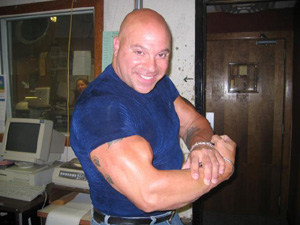
At the end of the last century, professional strongmen performed amazing feats, many of which have yet to be duplicated. This was the era that preceded “scientific strength training.” No branch of science had yet been developed to study such things as frequency of training, muscular recuperation. Still, amazing power was developed. It was done simply by practicing the two-arm and one-arm lifts that were popular at the time, along with bending spikes, horseshoes and iron bars.
Most of their strengths though were developed as the result of heavy manual labor. There were no forklifts in those days, and there was always employment for powerful men who could load heavy barrels and boxes on and off freight cars and wagons by hand. These early strengths athletes made their jobs part of their training. Even boxers and wrestlers of the time would often get hard manual-labor jobs as conditioning for their sport.
This work ethic has gone the way of the dinosaur. Modern day lifters and bodybuilders put hard labor in the same category as having a tooth pulled. They look at work as an enemy.
I was always a throwback to the early strongmen when it came to work. To me, hard work was always a challenge and completing such a job, an accomplishment. That’s why I joined the Marines at an early age. After leaving the Armed Forces. I always took the hardest, heaviest jobs I could find.
Up until recently when my strongman career took off, my b rother, Tony and I owned A&J Tiles. We built patios. I wasn’t just an owner-I also did the work, consisting of eight-t o-ten hours a day of moving heavy stone and marble slabs. It was always a challenge and completing such a job, an accomplishment. That’s why I joined the Marines at an early age. After leaving the Armed Forces. I always took the hardest, heaviest jobs I could find.
Up until recently when my strongman career took off, my b rother, Tony and I owned A&J Tiles. We built patios. I wasn’t just an owner-I also did the work, consisting of eight-t o-ten hours a day of moving heavy stone and marble slabs. It was always a challenge to out-work my employees. This might surprise you but I usually had my strongest workouts after a day of hardest work. It seemed to tune up my muscles for the gym! If you’re in your teens or early 20’s, and your goal is to build the strongest physique possible, I highly encourage you to get off your butt and get a hard labor job. Consider it part of your conditioning. Make sure you eat a big breakfast and pack a high calorie, nutritious lunch.
For the first couple of weeks, you will have to force yourself through those workouts at the gym. This is your “boot camp.” But once you get used to the regimen, you’ll be amazed at how much more strength you’ll have in your lifts. When you become accomplished as a strength athlete, and can make a living either as a performer or promoting products, you can quite the tough labor job and concentrate just on strength training. One thing I can guarantee you is that you’ll never regret having done the hard work. It will give you sustained strength and muscular stamina that no amount of lifting could have done by itself.
Part 2- IRON BULL “POWERBLAST” PRINCIPLES!
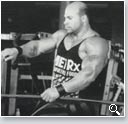
This system is appropriately named. To build my brand of EXPLOSIVE STRENGTH, you need to train like an animal! There’s no such thing as going to the gym, hitting a moderate workout and expecting to be an IRON BULL. You have to pound with those weights like there’s something wro ng with you..like you’re trying to punish yourself. On the other hand, you have to apply these principles and progressively work up to your heavy poundages so you won’t injure yourself. You have to “on fire” when you do these exercises, but you’ve got to be technical as well. You must break that barrier that everybody puts in their mind that says, “I can do it.” The POWERBLAST is the same technique used in Olympic lifting, but applied to the whole body. Like Olympic lifting, your body adapts to this style. The tendons and ligaments are trained to absorb the high impact of body momentum exercies and super- heavy forced reps.
A big difference between the POWERBLAST and standard bodybuilding is that each exercise in the POWERBLAST involves the entire body working synergistically. In bodybuilding, you isolate each muscle group with strict movment. A power curl, for example, works not only the biceps, but front delts and lower back as well. The pulley triceps presses done in this manner also works the abs and some of the upper back. As a result, I get functional, balanced physique development without having to do all the detailed work that a competitive bodybuilder does. I do no direct abdominal work, for example, yet my abs are defined and strong.
Here are some keys to success using the IRON BULL POWER BLAST:
1) Constant Change is important if you expect to continuously improve. You must always shock the body and keep your muscles from becoming immune to any specific training schedule. Train on different days and use different routines.
2) LISTEN TO YOUR BODY. You will be using the heaviest weights possible on this routine, include super heavy cheat reps, and assisted forced reps. It’s just as important, though, to back off ad train light on some days. You have to pay close attention to the signals your body gives you…feelings of pain and/or fatigue…and adjust your workouts appropriately.
3) ALLOW FOR RECOVERY TIME. I may take as many as three days off training following a super heavy workout. This depends on how I feel. The next week of training may have to be light, using medium poundage and 10 to 25 reps. Again, LISTEN TO YOUR BODY. Don’t let ego get the way of good judgment.
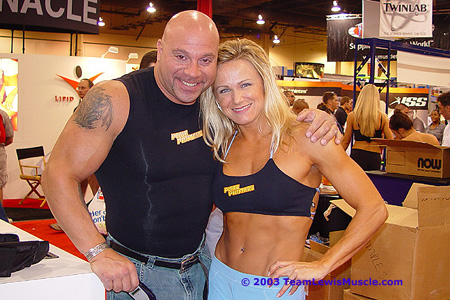
4) WORK UP TO HEAVY POUNDAGES. Always begin with light, warm-up poundage and add weight with each set (ascending pyramid), decreasing reps. Always use a spotter when performing maximum efforts. Blast the weight in an explosive movement. Bring it down quickly, but controlled. Avoid bouncing the weight, which can cause torn muscle. Following the heaviest set on the major power movements, do several sets decreasing poundage (descending sets), using slower negative movements
5) strength increases
At first you, you will progress quite rapidly. Go ahead and add weight whenever possible. At my level of strength, I have to be careful and sensible. I increase poundage in my workouts every six to eight months. Again, I listen to my body. One day, I may enter the gym feeling very strong and break my personal record in one or several exercises. Often, I’ve done an excess of 50 to 100 lbs. more in some exercises! Afterward, I always take time off, then back-cycle to my previous training poundages. This is the best way to hoist mammoth poundages safely and make steady progress beyond and physical limit.
Part 3-
THE IRON BULL’S WORKOUT ROUTINE-
Chest
Flat bench: 3/4 of sets never touch the chest
1. Do warm-up sets with lightweight 10-20 reps 2x
2. Medium weight, 10-15 reps 2x
3. Heavy weights or your max. 3-5 reps
4. Two sets of overloads 10 reps each; going 30-50 lb. over your max, with a spotter to aid in friendly pull from above on every rep if you feel strong Add another 30-50 lb. and do another two assisted sets.
5. Finish with two cool down sets-
A. Half of you heaviest, assisted if necessary until failure.
B. Drop to a lightweight, a little more than starting-reping until failure. This
Will conclude flat bench press.
Flat dumbbell fly’s: Never do this exercise with straight arms, bend your elbows. Slightly make sure to go to failure on the last two sets; this fills blood in the muscle to heal & grow.
3 sets only
1. Start with heaviest dumbbell you can handle. Use a spotter if needed for your elbows, doing about 10-15 reps.
2. Medium weight 10-or to failure reps, no assistance.
3. Light weight to failure. If you don’t exhaust within 30 reps use a heavier weight.
Peck deck: Slightly bent an elbow, if you feel you are cheating that’s OK. As the sets lighten the form will get easier until you exhaust.
3 sets only
1. As heavy as you can go 10-15 reps.
2. Medium weight 10- to failure
3. Medium-light weight 10- to failure
Cable crossovers: Start with medium weight because this is a dangerous exercise, warming up is very important as well as keeping you arms slightly bent.
3 sets only
1. Medium weight 10-15 reps.
2. Heavy weight 8-10 reps.
3. Medium-light 10- to failure
Shoulders
Seated front press: Smith machine or free weight shoulder press is harder but safer.
1. Starting with lightweight bring the bar down in front – to the bridge of your nose no
deeper 15-20 reps 2x.
2. Medium weight 10-15 reps 2x.
3. Maximum weight 5-10 reps 1x.
4. Overload at least 50 lb. with a spot on your elbows or overhead 10-15 reps 2x.
5. Cool downs drop to medium weight 10- fail if necessary a spot 1x.
6. Medium-light 10- failure 1x, a spotter if needed.
Seated dumbbell lateral raises : This move is a little odd but stick with it. It widens shoulders. This exercise will cause you
to use body momentum on heavy sets.
1. Bend back adjustable chair on a 45-degree angle. Sitting grab the heaviest dumbbells you think you can handle without hurting yourself. Holding the right dumbbell as leverage, steadily pull the left one up to the side not any further than your shoulder joint 10 reps only.
2. Medium weight repeating above 10 reps.
3. Medium-light weight 10 reps.
4. Repeat all above using right arm and same weights.
Triceps
French Press: Lying down on flat bench or in between squat rack grabbing straight bar almost in bench press position but hands apart 6 inches. Put arms up almost straight bending only at elbows.
1. Warm up using just bar or few plates doing at least 20 reps .
2. Med.- light doing 10 reps if your not doing all reps tries, eventually you will.
3. Heavy set 5-10 reps 2x.
4. Overload 30-50 lb. with a spotter behind pulling up all times 8-10 reps.
5. If you feel strong add 30-50 lb. And do another assisted set.
6. Descend to a medium weight 10-15 reps.
7. Med.-light weight 10-fail using a spotter only if needed.
One-arm dumbbell kickbacks: On a flat bench leaning right knee into it and right arm on it using A pendulum movement with left arm and weight bringing it up to your chest and squeezing it out behind you. Your left leg should be stretched out behind and you will be in a low stance .
1. Using the heaviest dumbbells 8-10 reps don’t worry about form on all exercises form comes with lighter sets and strengthening comes from heavier sets.
2. Medium weight 15-20 reps using same arm.
3. Med- light weight 15-20 reps.
4. Alternate arms.
Cable pushdowns: For cable pushdowns stand in front of cable attaching the or small straight bar to the upper cable with a close grip, feet together pulling down with bending elbows on the return up don’t pass the chin. .
1. Heavy 10-15 reps.
2. Medium 15-20 reps.
3. Med- light 20- failure.
4. Repeat 20-fail if possible.
Cable Skull crushes: You can also do skull crushes from the lower cable with a flat bench and a straight cable bar by having someone hand you the bar; pushing upward almost locking elbows and coming back almost to the nose. On these do two sets and do med- heavy weight until failure.
1. Heavy 10-15 reps.
2. Medium 15-20 reps.
3. Med- light 20- failure.
4. Repeat 20-fail if possible.
Biceps
Power curls off Squat rack: When curling the weight pull up bar with shoulder. With straight bar: shoulder wide grip, pull up to the hairline on the forehead- a complete half circle. This involves the forehead- a complete half circle forehead- a complete half circle. This involves the whole biceps from the elbow to the shoulder joint and gives the biceps a better peak.
1. 20 reps with a light weight 3x.
2. Medium weight 10-15 reps use body momentum when you have to.
3. Using a heavy weight, power up the curls by using your back- dipping your legs
3-5 reps 2x.
Seated dumbbell curls: Sitting in a 45-degree chair curl weights from left to right pulling the dumbbell up sideways like a hammer curl but halfway through the movement turn your palm to your face up passed your ear. The right leg is bent back for the left curl to act as a counter balance and the left one forward -opposite for the right curl.
1. Heaviest dumbbells you can handle6-8 reps
2. Medium weight 8-10 reps.
3. Med -light rep to failure.
Preacher cable curls: Use preacher bench with low cable pulley. Resting your armpit on the bench this is your pivot point. This exercise is very safe the biceps is pulled on an angle and cant tear your tendon.
1. Med-light set 15-20 reps one arm and than next.
2. Med-heavy 10-15 reps left to right arm.
3. Heavy set 8-10 reps.
Lastly sit on flat bench facing a mirror grab a medium weight dumbbell alternate curls as many reps as possible 2x.
Back
Pull-ups: Use a v shaped bar with some sort of box so you can reach the high bar. Grabbing the v bars pulls you up to the forehead only and back down again. For this exercise you don’t have to lower all the way; like all my exercises this builds strength, power and endurance. Sets 1st warm-up.
1. As many as possible
2. 10-15 Reps same way
3. 10-15 Reps same way
One arm dumbbell rows: This exercise is done leaning over a flat bench, one knee into the bench and the same hand in front acting as balance. The opposite leg extended back pulling the dumbbell from the floor up the side of the chest to the top of the shoulder, not letting it down until exercise is complete. All in the same arm, than switch.
1. Heaviest dumbbell 15-20 reps.
2. Medium weight 15-20 reps.
3. Med-light 15-20 reps.
4. Switch arms.
.
Lat pull downs: In the seated cable use a wide bar with the rollers tightly against the top of the legs. Pulling to the chest not behind the head this can cause neck injury; also by pulling to the chest you also can use body momentum make sure that your grabbing the bar wide.
1. Medium weight 15-20 reps 2x
2. Med-heavy 10-15 reps.
3. Heavy weight 8-10 reps with
assistance if needed.
4. Medium weight until failure.
Seated rows: You can alternate this with pull downs. For a wider back use a lat-bar handle or you can also use a v bar. The row machines with the foot pegs high are easier on the back. The back can take allot of exercise because it is a large muscle group. Don’t forget you can use body momentum on every heavy set.
1. Med-light 15-20 reps.
2. Med-heavy 10-15 reps.
3. Heavy weight 8-10 reps.
4. Med-light 20- failure.
Squeeze and stretch on the last few.
Hammer strength low isolated Machine: If the gym has this machine use it I suggest only doing one arm at a time. You don’t have to go all the way down do 3/4 Reps.
Row machine: This is a plate loaded machine, and you If the gym has this machine use it I suggest only doing one arm at a time don’t have to go all the way down do 3/4 Reps. Make sure your feet are secure.
1. 1-45 lb. plate on both sides, 15-20 reps, one arm than the next
2. 2-45 lb. plates 10-12 reps.
3. 8-10 reps as heavy as you can handle.
Cable pulls: Standing in the middle of the cable crossover machine with the right hand on the left lower cable pulley, and your opposite arm on the knee or thigh bending over like your throwing a
Frisbee pulls the cable across the front of your body.
3 sets of medium weight, 15 reps, doing alternate arms
Rear dumbbell fly’s: Sitting on the end of a flat bench where legs are free of the bench. Bent over chair from under your thighs with a pair of dumbbells from under your legs pull up the bells to floor level making like you’re a bird .
3 sets of 10-15 reps Med- lightweight
PART 4- QUOTES FROM THE BULL
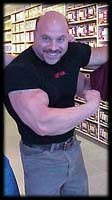
1) I use a lot of body momentum in my workouts. A lot of guys don’t believe in that. They believe in using super-strict form and isolating muscle groups. To me that method isn’t really practical. Think about life in general. When you do tasks such as taking the garbage out or lifting your bag into the overhead compartment in a plane, you use your body, not just one body part. When I train, everything I do, I use body momentum. For example if im doing a seated dumbbell press, When you’re doing big muscle groups such as the back, it’s really difficult to isolate. You’re using your biceps, rear delts, and core muscles. The only time I’d recommend isolation exercises is when you’re injured. Then you can use light weights to help the muscle repair. If nothing is hurt, I like to use power momentum like an Olympic lifter.
2) The way that bodybuilders train today, I doubt that any of them could go out and get a real job that requires manual labor. I think they’d fall apart. They look good, but they’re not built for physical labor. They wouldn’t do well in sports either. I used to do stuff like running hills with a 135-pound barbell on my back. When I was kid before entering the Marine Corps, I used to run several miles with a brick in each hand. I did all this stuff for functional strength.
3) I did the 1015 pound bench press with three spotters. What they don’t understand is that I’m doing strength training; I’m not trying to set a record. I’m not trying to bench a lot of weight with a pause at the bottom using super strict for. In real life you don’t pause at the bottom and use super strict form, so I’m not interested in powerlifting, although I once competed and did well. I was in the top 20 in the world at one point. At 180, I benched 475. I’m not into doing bench meets, I find it to be limited. When you go into your backyard at night and look at the stars with awe, you do so because there’s no end. If there was an end, would you go in your backyard and look at the stars the same way? Of course not. It’s not fascinating anymore. Now let’s say that I broke the bench press record at my body weight and did 750. Now I’m f*cked! Because even if I bench press 2000 with a spot, the guys who hate me will say that I’m only good for 750 and that the other lift is bullshit. Right now, I have the power since I never played by their rules. Once I go into their world, I’m bound by their rules. I’m not here to step on anyone’s toes or say that I’m better than everyone. I’m here to entertain people and bring some action to the sport. I look at myself like a strength entertainer and when I do these shows, people get off on it.
4) I benched 1015 pounds with a spotter, I do 150 pound dumbbell curls and tricep kick backs with 150 for 20 reps, 455lbs skull crushers, 155lbs lateral raises. Lifters should come to my world.
5) I think I make the sport much more entertaining and bring more attention to it. when people go get pictures with Ronnie Coleman, they look at him and say to themselves, “I could never look like this guy!” He’s out of reach for them. Yet when they come to my table and talk to me, they realize I’m a regular guy. They realize that they could use my style and go a long way with it.
6) I had Anthony Clark spot me at a show one time doing an 800-pound bench press. After that, he got in front of the crowd and told everyone that I inspired him to go after the record and be the first guy to bench press 800
PART 5- CONCLUSION-
At 5’11 and at 235lbs, Jimmy the Bull benched 1,015lbs! He described the experience as if he just went through a black hole, because he blacked out for a second. Jimmy also does dumbbell fly benches with dumbbells that weigh over 200lbs. He has also been into acting and he is into martial arts. If you are interested in some of Jimmy’s principles then give them a try. It’s not that his system is right or wrong, it’s just another perspective and exciting option of training that you can try.

